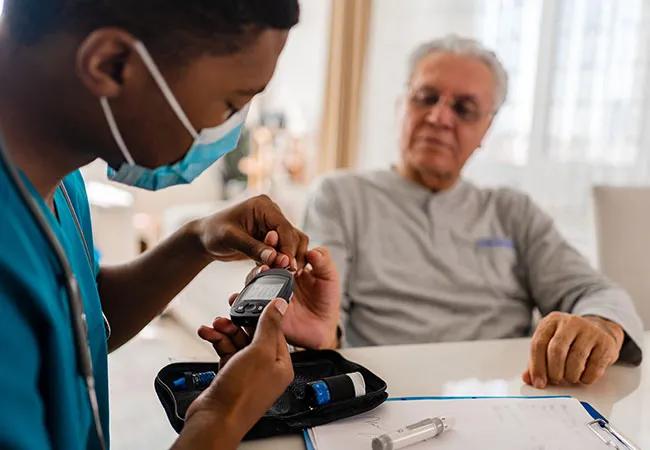Two patient stories highlight benefits of in-home care

When the COVID-19 pandemic began in 2020, Cleveland Clinic ramped up many of its at-home services. Two recent experiences highlight the ability of nurses to be part of teams that provide patients with optimal care in their homes.
Advertisement
Cleveland Clinic is a non-profit academic medical center. Advertising on our site helps support our mission. We do not endorse non-Cleveland Clinic products or services. Policy
The nurses work with Cleveland Clinic’s Center for Connected Care, which offers services ranging from respiratory therapy and infusion pharmacy to hospice care.
Like many healthcare providers, Cleveland Clinic responded to the pandemic in part by bolstering its telehealth services, including the addition of a home monitoring program for COVID-19 patients.
“We’ve been able to leverage that technology to assist with chronic disease management,” says Michelle Card, MSN, RN, CCCTM, who serves as Nursing Director of Value Based Contracting and oversees ambulatory care management.
Nurse primary care coordinators who work in ambulatory care management check on patients with chronic diseases via biweekly phone calls and the healthcare system’s MyChart Care Companion platform, a technology available through the Epic electronic medical record system to monitor patients and their symptoms. Earlier this year, these remote touch points helped one patient with chronic obstructive pulmonary disease (COPD) avoid hospitalization.
During a routine phone call, the nurse primary care coordinator learned that the patient was experiencing increased shortness of breath, cough and sputum production and using more medication. The nurse paged the Cleveland Clinic Community Care virtualist team, and a physician team member initiated a virtual visit with the patient within hours. Based on the visit, the physician activated Urgent Dispatch to the patient’s house to perform a chest X-ray, administer an intramuscular steroid injection to reduce inflammation and prescribe needed medication. The next day, an advanced practice provider from Urgent Dispatch visited the patient to assess the treatment’s effectiveness.
Advertisement
Two weeks later, the nurse primary care coordinator called the patient, who was stable. “Implementing this safety net kept the patient out of the ED, and if they had gone to the ED with COPD exacerbations, they likely would have been admitted to the hospital,” says Card. “Working as a team with social workers, pharmacists, virtualist providers and Urgent Dispatch allowed us to care for the patient safely at home.”
During the COVID-19 pandemic, hospice nurses have increasingly helped discharge patients from intensive care units, where they had been enrolled in hospice, to their homes to die surrounded by family members who were unable to visit them in the hospital. Some of these patients require oxygen and would not have survived the trip home following ventilator extubation, so nurses travel with the patients and extubate them at home.
“Every one of these cases brings a tear to my eye,” says Jennifer Ference, MSN, RN, CHPN, Nurse Manager for Cleveland Clinic Hospice. “There are such amazing stories behind the reasons for our home extubations.”
One of those stories involves a quadriplegic patient who went into respiratory failure and was placed on a ventilator during his last hospitalization. He wanted to die at home on his farm, surrounded by his family and animals.
“He wanted to come off of the ventilator knowing what the end result would be,” says Ference. She talked through the decision with the inpatient caregivers, the patient and his wife. The day before transporting him, Ference went to the home to ensure all the necessary equipment was in place. She and Ruth Ford, RN, a case manager with Cleveland Clinic Hospice, also talked to the family about what to expect.
Advertisement
“Once we get patients home and comfortable, we always step out of the way and give them time to say goodbye to their families,” says Ference. In this case, not only did the patient’s wife, children and grandchildren say goodbye, but his dogs and baby goats were brought into the room, too.
Performing home extubations allows patients to die in familiar, comfortable surroundings, says Ford. “They are not attached to a bunch of medical equipment, and there are no alarms ringing and distractions in the hallway,” she says. “Patients can die with dignity.”
Home hospice nurses have performed about a half dozen home extubations since the pandemic began. “You always feel a lot of love in the room,” says Ference. “It’s such an honor to be invited into that space with the patients and their families.”
Advertisement
Advertisement

Study illuminates value of shared decision-making

How hospitals can weave ethics into daily nursing practice to strengthen patient-centered care

Mobility carts provide exercises and tools

Nurse researchers explore the relationship between readmission risk scores and acute care transfers

Guiding nurses amid a constantly evolving healthcare landscape

Ideation session generates solutions to medication administration errors

Caregivers spearhead changes that improve patient care, shape hospital culture

Building a culture that supports, engages and empowers nursing staff